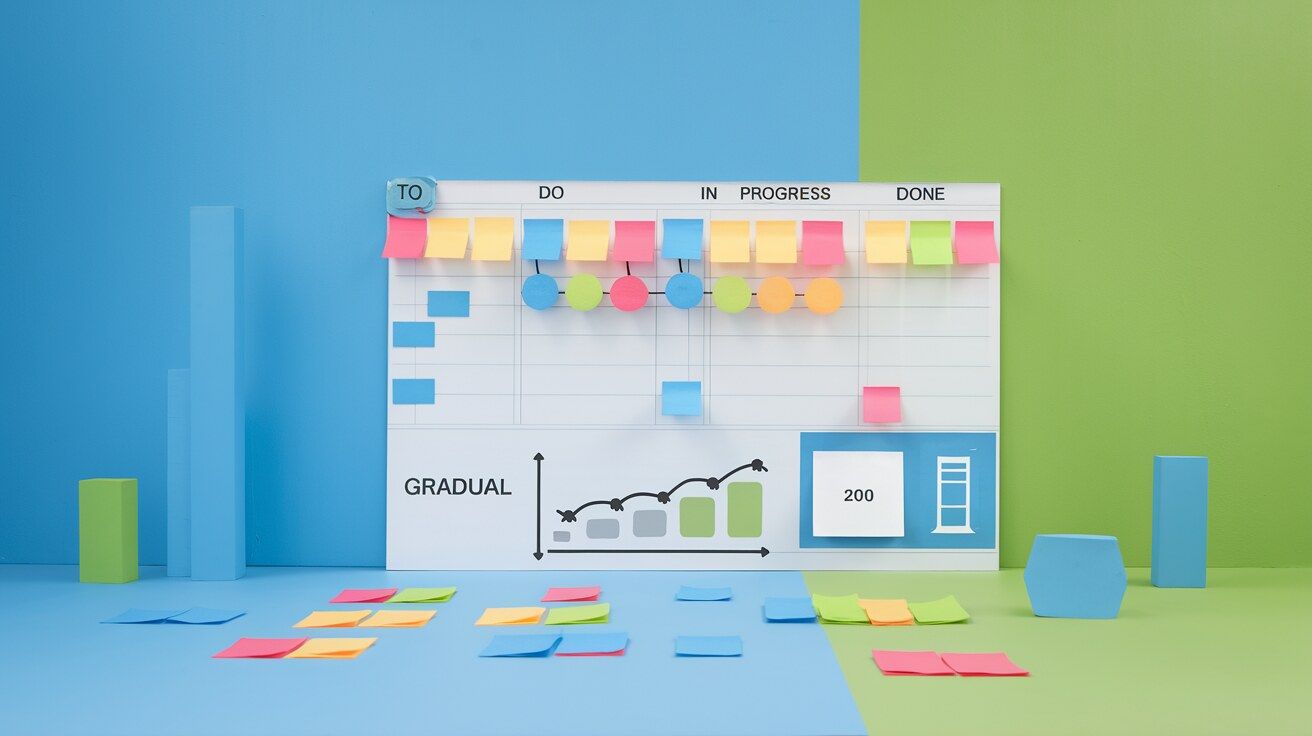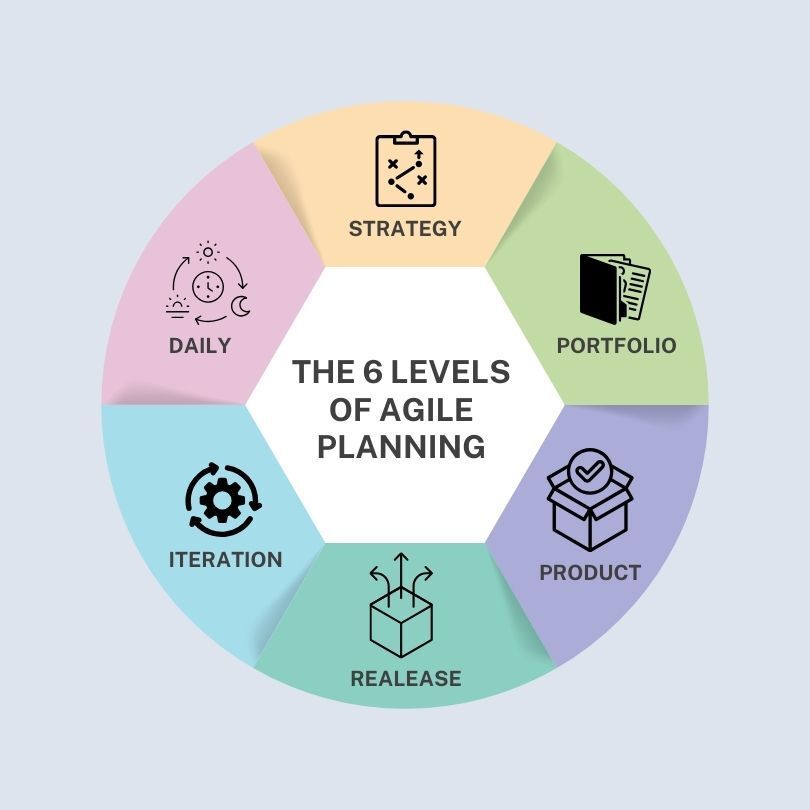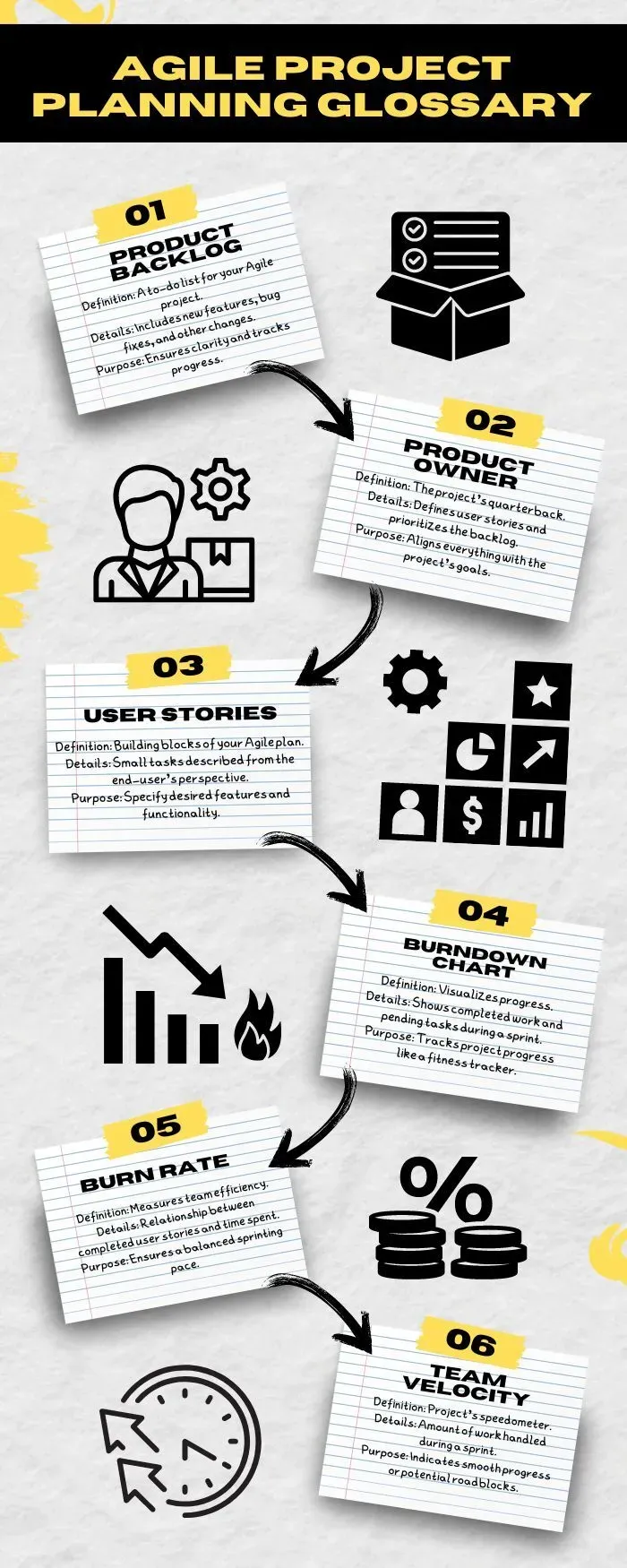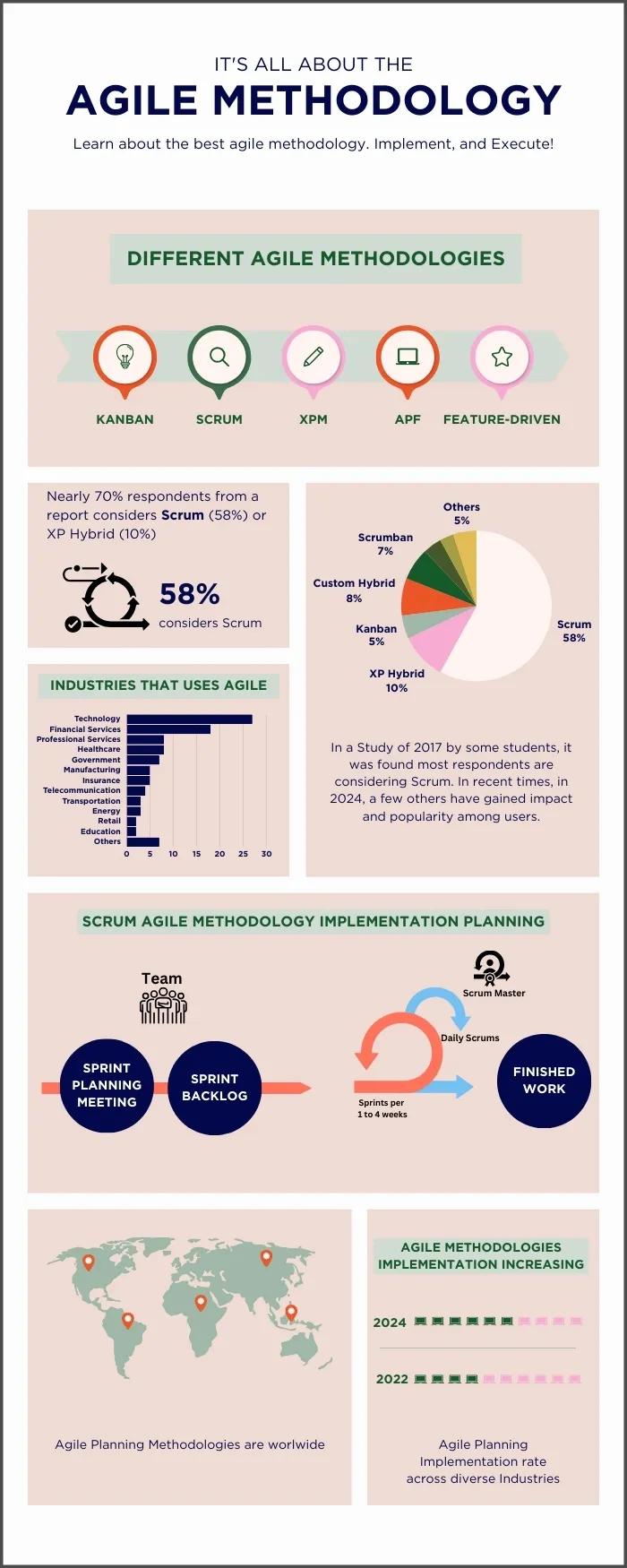Agile Planning: Everything You Need to Know with Best Practices & Examples

Agile planning is a flexible project management approach for planning and adjusting projects in stages.
Instead of following a traditional plan, agile teams work in short sprints to continuously improve the product.
I’ve seen firsthand how Agile planning changed my whole working process compared to rigid methods.
It helped me to focus on flexibility and continuous improvement in my software development work process. If you want the same improvement, Agile planning is the way to go.
In this article, I tried to cover —
- What is Agile Planning (with real-life examples)
- Why is it important?
- Different methodologies (broken down into most effective ones)
- And how it can benefit you and your team.
So, let’s begin!
What is Agile Planning?
Agile planning is a flexible project management approach. It focuses on adaptability, collaboration, and continuous improvement.
Usually, traditional methods create detailed plans upfront. However, Agile planning allows for adjustments based on users' feedback.
Here are some of the initial things that make Agile planning successful for project managers —
- User Stories: Capturing and detailing all interactive user requirements in one place.
- Roadmaps: Publish release schedule based on user stories to get more done in short periods.
- Sprints: Short, focused periods of intensive teamwork to successfully launch releases.
- Feedback Loops: Continuous collaboration between team and clients to constantly update the product in real-time.
The 6 Levels of Agile Planning: How You Should Structure
Agile planning resembles an onion, with layers that build upon each other. As you peel back these layers, you reveal a more detailed and frequent planning process.
So, let’s explore these levels and understand their significance within the broader Agile framework.
Note: Some of the terminologies may sound new at first, in the next section I tried to break down everything with usable examples.

Strategy
At the pinnacle of Agile planning, you define your long-term vision and strategic objectives. Here, organizations identify the necessary resources and capabilities to achieve their goals.
Well, I think of it as laying the groundwork for everything that follows.
Portfolio
Now, your focus shifts to managing a collection of projects or products. Here, prioritization, resource allocation, and alignment with business objectives take center stage.
Plus, portfolio management helps use your resources efficiently and align projects with strategy.
Product
Here, your teams outline the overall product strategy —
- Decisions about development approaches
- Timelines
- Feature prioritization happen at this level
In this case, Agile planning software simplifies processes, ensuring timely delivery of product features.
Release
Release planning translates the product roadmap into specific releases. It involves prioritizing user stories, setting timelines, assessing team capacities, and defining features or functionality for each release.
Moreover, it ensures manageable progress aligned with agile capacity planning principles.
Iteration
In short iterations (usually 1 to 4 weeks), teams break down user stories into smaller tasks and estimate effort. This approach maintains a consistent workflow and helps meet short-term goals.
Daily
Daily stand-up or scrum meetings keep the team aligned, focused, and ready to resolve immediate issues. In addition, at this level you must maintain momentum, as well as keep track of current tasks and priorities.
How to Design Your Agile Project Planning
When planning an Agile project, you must balance flexibility with structured milestones. Your plan needs to adjust to changes while keeping your team focused on the most important things.
So, here are the steps I followed for effective Agile planning.
Document Project Vision (Strategy and Portfolio)
You begin by creating a user story. This method is popular in Agile, especially in software development. A user story outlines who your user is, what they need, and why it matters.
For example —
"As a [user], I want [feature or product] that gives me [benefit]."
When you create a user story, the objective, and strategy of your project become more easy. Now, you should develop your project KPIs to measure success. And then outline the solutions.
Well, it may include one or multiple products to help you prioritize your tasks. By the time you finish this phase, you’ll have —
- An easy-to-understand user story
- Proper objectives and strategy
- A list of priority products or services
Create a Product Roadmap
Here, you must lay out the steps you’ll need to finish your project.
In this case, you pick each item from your portfolio and make a roadmap. From this roadmap, you’ll get a detailed roadmap highlighting the features you’ll need to reach your project goals.
Usually, it looks like a grid with objectives, main features, and major metrics for each release.
Release Planning
In Agile methodology, you use multiple small development cycles called sprints. Unlike the single deadline in conventional waterfall management, each sprint ends with the delivery of new features.
So, start with a high-level plan for feature releases. Before each sprint, review and adjust this plan.
Create Tasks Based on User Stories
Every project and user need is different, so this step is ongoing. You create actionable tasks from real user stories. Team members then focus on adding new features, updating existing ones, or improving functionality.
It keeps the development process aligned with user requirements.
Populate Product Backlog
Start by building your product backlog. It's basically a list of tasks and user stories for the entire project.
You can include tasks that aren't in the current sprint but are planned for future ones. Use this list to gather new tasks from feedback, obstacles, or issues.
Prioritize these tasks based on user needs and project timelines. This way, you focus on the most important ones first.
Plan the Iteration
Next, you need to plan the iteration. Create tasks, assign team members, and decide on deliverables for each release. In Scrum, this step is called Sprint Planning. Sprints usually last 1-3 weeks.
During this time, the team focuses on specific tasks. Each sprint includes current, future, and backlog tasks. Once a sprint starts, try not to change tasks unless everyone agrees. I’ve seen increased workplace productivity through this method.
Even if you don't use sprints, plan activities for a set period. This keeps the team aligned with the right priorities.
Plan Daily Stand-ups
If you use Scrum, your daily Stand-up is super important. Led by the Scrum Master, you'll meet for 15 minutes to discuss the day's tasks and any obstacles.
Using an Agile project management tool, your team will answer three questions and submit their updates —
- What are you working on today?
- What is your plan for tomorrow?
- Have you encountered any roadblocks?
Monitor and Adapt
Tracking progress against your overall goals, iteration plans, and product roadmap is vital in Agile planning. From my side, this is a very crucial step. You have to align your teams for the best outcomes even if they are working remotely.
For remote teams I’d recommend you to monitor your remote employees.
Also try to identify and address any deviations quickly.
At the end of each sprint, you can pinpoint the improvement areas and apply these lessons to future iterations. Plus, it's important to schedule, prepare, and communicate well.
Many teams use team monitoring softwares like Apploye and different project management softwares like Trello, Asana, Clickup.
With these apps, you can keep your teams organized and productive, which is crucial for achieving goals.
Start Monitoring Your Team with Apploye!
Why is Agile Planning Important?
Agile planning plays a vital role in effective project management. It focuses on emphasizing adaptability, customer satisfaction, and continuous improvement. So, here’s why it matters —
- Flexibility: Agile planning keeps things flexible with its dynamic framework! Your team can adjust on the fly, instead of being stuck in a box.
- Customer-Centric Approach: By using regular feedback loops, Agile teams align project goals with customer needs. It leads to increased satisfaction, as 59% of Agile users report better collaboration.
- Balancing Predictability and Value: In medium and large organizations, predictability often leads to success. Smaller companies, however, focus on delivering value. Here, Agile planning helps you achieve this balance by analyzing ideas in terms of business goals and ROI.
- Real-Time Adjustments: Agile planning enables your teams to make real-time adjustments based on new information. It encourages frequent delivery of small work increments, reducing risk and improving flexibility.
- Industry Shift: The latest data indicates that 33% of organizations have used Agile planning tools for large projects in the past three to five years. This trend reflects a significant shift towards Agile methods.
Agile Project Planning Terms & Glossaries You Need to Know
Here are a list of frequent used terms in agile project management you must know. Understanding of these unique terms will make your learning and implementation process much faster as a beginner.

1. Product Backlog
The product backlog is like a to-do list for your Agile project.
It includes everything you want to achieve, such as new features, bug fixes, and other changes. By documenting these items, you can ensure clarity and keep track of what needs to be done.
2. Product Owner
Think of the product owner as the project’s quarterback. They define user stories (more on that in a moment) and prioritize the product backlog. Their job is to make sure everything aligns with the project’s goals.
3. User Stories
As I mentioned earlier, user stories are the building blocks of your Agile plan. These are small tasks described from the end-user’s perspective. They spell out the desired features and functionality.
You can imagine them as bite-sized pieces of work that add up to the bigger picture.
4. Burndown Chart
You can visualize progress with a burndown chart.
It shows how much work your team has completed during a sprint (a time-bound development cycle) and what tasks or hours are still pending.
5. Burn Rate
The burn rate measures your Agile team’s efficiency. It’s the relationship between completed user stories and the time spent.
If your burn rate is too high, you might be sprinting too fast and risking burnout.
Again, if it’s too low, you’re not moving quickly enough.
6. Team Velocity
Think of team velocity as your project’s speedometer. It tells you how much work your team can handle during a sprint. In fact, high velocity means you’re cruising along smoothly, while low velocity might signal roadblocks.
7. Story Point Estimation
When estimating effort, we use story points. These units help calculate how much work a user story requires. Consider risk, complexity, and repetition. It’s like figuring out how many steps it takes to climb a mountain—some paths are steeper than others!
Similar Read:
↘️Challenges of Project Management
Different Agile Methodologies for Different Use Cases
You know how Agile improved my project management? It was all about efficiency, flexibility, and continuous delivery.
You can get the same benefits but for that you need to understand the methodologies properly first. Here are the eight popular methods that worked for me:

Kanban
Kanban is a visual board that shows exactly what your team is working on. You can see what stage they’re at and if anything is getting stuck.
Plus, you can spot bottlenecks and keep projects moving smoothly, saving you time and money.
FYI, Lean production engineer Taiichi Ohno developed Kanban.
However, Modern Kanban was inspired by supermarket shelf-stocking techniques from the late 1940s. I find Kanban pretty easy to apply.
- You write tasks on sticky notes, stick them on a board (think whiteboard!),
- Move them through stages like "To Do", "Doing," and "Done".
- Keeps everyone on the same page and helps projects flow smoothly.
Many teams effectively implement Kanban using agile planning tools, optimizing workflow and project delivery.
Scrum
Scrum focuses on project management and development. In Scrum, the product owner collaborates with businesses and IT teams to create and manage a product backlog.
Plus, the work is divided into sprints (typically lasting two weeks to a month), with regular reviews and priority adjustments. I admire this iterative process as it ensures continuous improvement and adaptability.
Since Agile project planning in Scrum requires regular feedback and adjustments, it’s efficient for complex projects.
For instance, launching a marketing campaign, building new medical equipment, developing a SaaS product, etc.
Extreme Project Management (XPM)
In my experience, Extreme Project Management (XPM) is perfect for highly complex projects with lots of uncertainty. It focuses on flexibility and adaptation, constantly changing to achieve your desired results.
In XPM, teams often change strategies weekly, accepting frequent and spontaneous changes. Sprints are short, lasting only a few weeks, which allows for quick adjustments and continuous improvement.
Ultimately, I believe this trial-and-error approach and frequent self-correction make XPM ideal for projects where unpredictability is a key factor.
Extreme Programming (XP)
If you love to maintain quick communication and collaboration between you and the developers, Extreme Programming (XP) will let you do so. Your feedback on the most valuable features guides the development process.
The developers use this feedback to plan each new set of software improvements. Hence, the product changes to meet your needs.
Besides, the XP development cycle includes regular testing and innovation every few weeks.
That said, supported by agile planning principles, XP keeps the focus on delivering high-quality, user-centric software.
Feature-Driven Development
As a developer-centric Agile methodology, FDD focuses on creating builds through regular, bi-weekly iterations. Unlike XP and Scrum, FDD follows strict procedures, including domain walkthroughs, coding, design, and inspections.
Here’s how it works —
- Begin by building a model and compiling a list of features.
- For each feature, create a detailed development and design plan.
- Execute inspections and unit tests to ensure readiness for the build stage.
All in all, FDD’s structured approach makes it a reliable choice for teams implementing agile planning in software engineering effectively.
Adaptive Project Framework (APF)
The APF, also known as Adaptive Project Management (APM), is designed to handle projects where unknown factors can occur unexpectedly.
Particularly useful for IT projects, APF operates on the premise that project resources (such as budgets, timelines, and team members) can change.
Instead of focusing solely on what a project needs, I relied on APF, which focuses on using the resources currently available. This flexible and adaptive strategy allows your teams to adjust quickly and maintain progress despite changing circumstances.
Consider using an agile planning app to increase efficiency and adaptability within this framework. For instance, I use Clickup.
Crystal Methodology
Crystal Methodology is a set of Agile methods introduced by Alistair Cockburn, one of the authors of the Agile Manifesto. It includes variations like —
- Crystal Clear
- Crystal Yellow
- Crystal Red
In addition, the Crystal family organizes projects based on three factors: team size, system criticality, and project priorities. Mainly, system criticality is divided into four levels—
- Comfort (C)
- Discretionary Money (D)
- Essential Money (E)
- Life (L)
As projects grow, they need more people and diverse roles. Plus, Crystal focuses on early delivery, frequent updates, minimal bureaucracy, and high user involvement. It highlights interaction, communication, and community, making it a lightweight approach in agile planning.
Dynamic Systems Development Method (DSDM)
The Dynamic Systems Development Method (DSDM) is an Agile methodology that spans the entire agile software development life cycle. Unlike other Agile methods, DSDM is more structured and rigorous.
I’ve found four phases of the life cycle —
- Probability and business study
- Functional model or prototype iteration
- Design and build iteration
- Implementation
This structure ensures each project stage is thoroughly planned and executed. DSDM’s detailed approach suits projects needing a disciplined and methodical process, fitting well with enterprise agile planning practices.
Best Practices in Agile Project Planning
To master Agile project planning, you must follow some major practices that improve team collaboration and simplify workflows. So, here are some must-try strategies to up your Agile planning game.
Collaborate
Get everyone involved from the start. You need to bring together developers, testers, product owners, and stakeholders in the planning process. When you include the whole team, everyone’s ideas are heard.
That way it leads to a common understanding and a stronger commitment to the project’s goals.
Create an Agile Manifesto
Make an Agile Manifesto to guide your workflows. This document should highlight teamwork, flexibility, and keeping customers happy.
Over strict processes, it values people over software, working with customers over rigid contracts, and adapting to change over rigid plans.
You can even incorporate the levels of Agile planning into your manifesto for a balanced yet flexible approach.
Prioritization
Prioritize your tasks and user stories based on their importance to the customer and the business.
You can use methods like MoSCoW (Must-Have, Should-Have, Could-Have, Won't-Have) to tell apart the vital features from the optional ones.
This way, you stay focused on what really matters and deliver the most value.
Continuously Improve
Keep revisiting and updating the backlog based on feedback and changing priorities. Regular updates ensure the backlog mirrors the current state of the project, helping you stay responsive and adaptable.
Be Adaptable
Always be ready to change. Stay flexible when new insights come in, or priorities shift. Agile planning relies on changing needs, letting you make adjustments as the project progresses.
When you accept adaptability, you can handle unexpected challenges better. It ensures your project stays on track with its goals.
Risk Management
Start by spotting potential risks early in the planning phase. Think about what could go wrong and come up with ways to deal with those risks.
Here, you’ll have to include backup plans in your project outline. Plus, you can maintain steady progress with good risk management.
On top of that, knowing the 5 levels of planning in Agile can make it easier to assess and manage risks effectively.
What are the 12 Agile Principles You Should Be Aware Of?
Agile methodology stands on four core values. And based on those values, there are 12 principles that you can easily embrace according to your team’s requirements.
1. Give Customers Quick. Ongoing Improvement and Delivery
When you give your customers new updates, they get to see more changes in your product. I mean, they can literally notice the changes you’re bringing into for them. Hence, your customer becomes happy and satisfied.
In fact, the Harvard Business Review reported that if you can satisfy just 5% of your customers, your profits could jump from 25% to 95%.
2. Accept Changes, Even if it’s Late in the Project
A big part of the Agile framework is its flexibility. In fact, if you stay rigid in Agile's iterate framework, you'll do more damage than good.
3. Supply Value Continuously
You must deliver value to your stakeholders or customers continuously. That way, you can minimize the chance of losing interest in you.
4. Get your Projects Out of Silos
Remember, collaboration is important in the Agile framework. You should aim to get people to collaborate more frequently instead of working on their own projects.
5. Get Motivated People to Work on Projects
I’ve experienced that Agile works best when my team works attentively and actively to gain the same objective. So, inspire your team and motivate them so they can focus.
6. Always try to have Face-to-Face Communication
You might work with an outsourced team; even I've done so. In this case, you should try to communicate with your team members via Zoom Calls. Hence, all team members can see each other, creating a workly bond.
7. The Main Measure of Growth is Working Software
The most important thing that teams should strive for with the Agile framework is the product. The goal here is to prioritize functional software over everything else.
In Agile frameworks, teams must focus on the product as a priority. In this case, priority goes to functional software more than anything else.
8. Maintain a Steady Pace of Work
Some aspects of Agile can be fast-paced, but it shouldn't be so fast that team members burn out. The goal is to maintain sustainability throughout the project.
There are some parts of Agile that can get super fast. However, they shouldn't exhaust your team. Throughout the project, sustainability is key.
9. Agility Requires Continual Excellence
If your team can develop great code in one sprint, it’s for sure that they can do so again. In fact, when your team produces quality work consistently, your team moves faster in the long run.
10. Keep it Simple
Sometimes, the simplest answer is the best one. A big part of Agile is keeping things simple and finding straightforward solutions.
11. A Self-organizing Team Adds the Maximum Value
Proactive teams, much like in principle #5, keep adding value as they carry their workload.
12. Improve your Work by Reflecting and Adjusting
Regular retrospective meetings are a staple in Agile. You can use them to reflect on your team's performance and tweak your approach to improve future results.
Agile Planning Template
An agile planning template keeps things on track and makes deliverables easier to review. It stores all the results from your sprint planning meetings.
This way, your team gets a clear picture of the project.
You can discuss new updates, check the timeline, and see what the team can handle.
Agile Kanban Boards
Start your sprint planning with a Kanban board. Scrum teams love visuals, but some team members might prefer a traditional sprint planning method.
Plus, Kanban boards help you organize and track tasks throughout the sprint.
My recommendation would be trello board for Kanban. It's really faster then its competitors and you can strat off with a free plan.
Developers' Task Lists
Developers might like a list view better. It shows all their tasks in one spot, including priorities and progress. They can also create to-do lists to manage their work efficiently within the sprint plan.
Gantt Charts for Tracking Improvement
Stakeholders usually prefer Gantt charts. These charts give you a clear view of the project's timeline and progress. While Gantt charts are common in traditional methods like waterfall, they can be adapted for agile sprints too.
Moreover, they offer a visual timeline and can be customized with columns or switched to a sheet view for more detailed tracking.
Final Words
To wrap it up, Agile Planning is all about being flexible, working together, and always improving. By focusing on user stories and feedback, you can keep your projects on track and deliver real value.
As we move forward, using Agile Planning helps you adapt to changes and meet customer needs.
That said, tools like Apployee can help you. With features like time tracking, task management, and detailed reports, Apployee makes your workflow smoother. Together, you can achieve better results and stay on top.
So, try Apployee today!
You may also like:
↘️ Why it is Important to Track Time in Project Management?
↘️ Complete Virtual Project Management Guide (2025)
↘️ Google Tools You Need for Project Management in 2025
↘️ Best Time Tracking & Productivity Softwares for Project Management
Related FAQs Regarding Agile Planning
What is the Agile lifecycle model?
The agile lifecycle model is a structured series of stages that a product goes through from start to finish. The six stages are concept, iteration, inception, release, retirement, and maintenance.
What are the 3 C's in Agile?
The 3 C’s in Agile are collaboration, coordination, and communication. As part of Agile practice, these principles ensure that team members communicate well, collaborate effectively, and stay organized.
What is the most popular Agile methodology?
The most popular Agile methodology is Scrum. Teams operate in two to four-week sprints, defined by scrum masters and product owners. This approach improves efficiency and clarity, making it widely used in Agile development.
What is the PI planning process in Agile?
Program increment (PI) planning is an event where Agile teams and business stakeholders create a shared vision. The team reviews the backlog, sets priorities, analyzes goals, identifies dependencies, and decides the new direction for the business.
